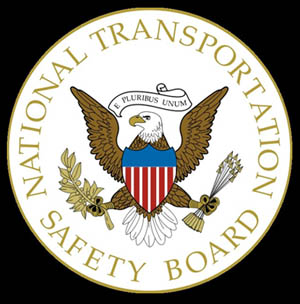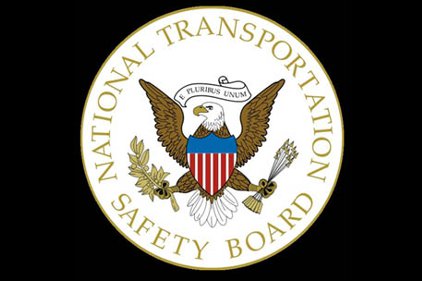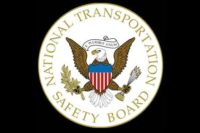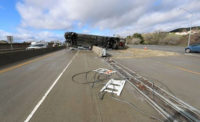 A fatal accident in which a freight train struck a parade float in Texas last November was caused by the failure of both the city and the parade organizer to address the risks associated with routing a parade through an active grade crossing, the National Transportation Safety Board (NTSB) said today.
A fatal accident in which a freight train struck a parade float in Texas last November was caused by the failure of both the city and the parade organizer to address the risks associated with routing a parade through an active grade crossing, the National Transportation Safety Board (NTSB) said today.
“This terrible collision between a fast-moving freight train and a slow-rolling parade float of veterans and their loved ones should never have occurred,” said NTSB Chairman Deborah A.P. Hersman at a Board meeting today. “Parade and event organizers must identify and manage hazards in advance to ensure a safe outcome for participants and spectators.”
Float carried a dozen veterans and their spouses
At about 4:35 p.m. CT on November 15, 2012, a truck-tractor flatbed trailer combination unit being used as a parade float as part of a procession honoring wounded veterans approached a section of the parade route that traversed an active highway-railroad grade crossing in Midland, Texas. The float, which carried 12 veterans and their spouses and was escorted by two law enforcement vehicles, entered the grade crossing after the grade-crossing warning system had activated. The float continued across the railroad tracks at an estimated speed of 5 mph.
At about the same time, an 84-car Union Pacific freight train approached the crossing from the west at a speed of 62 mph. As the front of the float crossed the tracks, the train engineer sounded the horn and placed the train into emergency braking. Seconds later, the train reached the crossing and struck the right rear section of the float.
As a result of the collision, four float passengers were killed and 11 passengers and a sheriff’s deputy were injured. The two train crewmembers, the float driver, and nine other passengers were uninjured.
An "expectancy of safety"
For 34 minutes prior to the accident, the float had traveled along the parade route with a continuous police escort, which allowed the float to proceed through red traffic signal lights at four intersections without stopping. This created what investigators called an “expectancy of safety and right of way,” which the NTSB said contributed to the cause of the accident, because it led the driver to conclude that police were controlling all intersections and associated traffic hazards.
The float driver told investigators that he did not see the flashing lights of the grade-crossing warning system or detect the presence of the train until the float was on the tracks because he was looking at his side-view mirror to monitor the well-being of his float passengers as he negotiated a dip in the roadway on approach to the grade crossing.
Noise contributed as well
The NTSB concluded that the noise generated by the parade, combined with the float driver’s expectation of safety, likely reduced his ability to hear or properly interpret the grade crossing system warning bells and lights, as well as the train horn.
The NTSB determined that the grade crossing system provided the required 20 seconds of advance warning through warning bells, lights and gates. However, the NTSB cited as another contributing factor to the collision, the lack of visual traffic signal cues to indicate to the police officers escorting the float that an approaching train had preempted the normal highway traffic signal sequence at the intersection adjacent to the grade crossing, which would have provided as much as 10 additional seconds to warn law enforcement officers and the float driver of the approaching train.
A "lax and informal manner"
The investigation revealed that the parade organizer, Show of Support, failed to obtain a parade permit and the city of Midland failed to enforce its ordinance by allowing the parade to take place anyway, which investigators characterized as indicative of the “lax and informal manner” by which the parade was organized, approved and executed.
Had the parade organizer and the city of Midland created and followed a safety plan that included a requirement that railroads be notified of any parade route that crossed the tracks, the railroad may have arranged to halt train traffic, restrict train speeds, or provide a flagman, any one of which would likely have prevented the accident.
Parade accidents elsewhere in U.S.
As part of the investigation, the NTSB also looked at three other parade accidents occurring this year in Bangor, Maine; Edmond, Okla.; and Damascus, Va.; and determined that many communities and organizations across the U.S. don’t conduct risk assessments and implement safety plans. The NTSB is calling for the development of guidelines that state and local officials can use as a resource for the safe planning and operation of parades and other special events. The NTSB is also encouraging jurisdictions across the U.S. to require written safety plans as part of the approval process for a parade or special event,.
As a result of the investigation, the NTSB made a total of six recommendations to the Federal Highway Administration, the Federal Railroad Administration, the city of Midland, the National League of Cities, the National Association of Counties, the National Association of Towns and Townships, the United States Conference of Mayors, the International City/County Management Association, the International City/County Management Association, the International Festivals and Events Association, the National League of Cities, and the National Association of Counties.
A synopsis of the NTSB report, including the probable cause, findings, and a complete list of the safety recommendations, is available at http://go.usa.gov/WBTR. The full report will be available on the website in several weeks.


